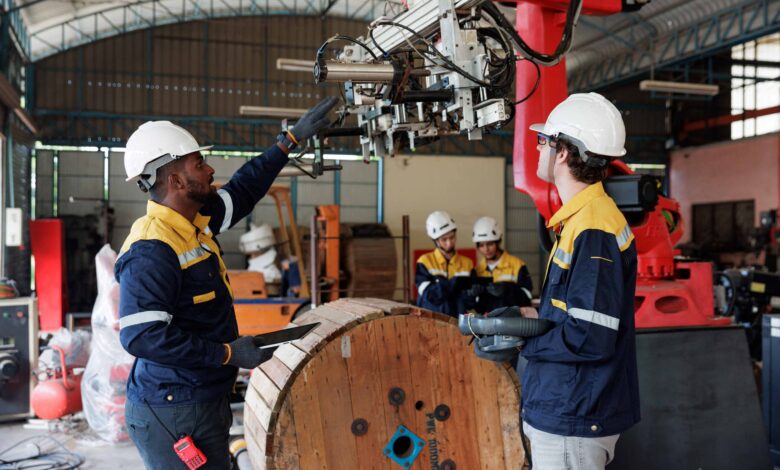
AI adoption is accelerating across industries, with enterprises under increasing pressure to digitally transform operations to stay competitive. But deploying AI on the factory floor or in other real-world environments is not as simple as adding a large language model solution (LLMs) like ChatGPT or Gemini. These powerful LLMs are impressive, but they are resource-intensive, require cloud connectivity and struggle in environments where real-time decision making and localized processing are critical.
Enter Edge AI and small language models (SLMs) leveraging physical AI. These agile, purpose-built physical AI systems are optimized for specific tasks and deliver low latency while processing directly on the device. Directly at the network edge– whether analyzing cameras with OT sensors and IoT devices, complex robotic systems or programmable logic controllers (PLC) data streams – SLMs enable scalable, efficient AI deployments, making them essential for the next evolution of real-time industrial intelligence.
While LLMs revolutionized natural language processing and content generation, these models rely on large compute resources and access to significant amounts of cloud data. This makes them less reliable for businesses that value security and require insights for immediate decision-making. Industrial settings such as factory floors, mines, airports and energy sites require rapid data analysis, minimal latency and high availability – often in locations with limited or no connectivity.
According to Gartner, 74% of CIOs are under pressure to implement AI strategies, yet many struggle to define a clear return on investment. This disconnect is even more pronounced in manufacturing, where IDC projects the number of connected IoT devices will exceed 41 billion by 2025. While the data is abundant, transforming it into actionable insights remains challenging.
In manufacturing, SLMs and Edge AI platforms offer a practical solution. These lightweight physical AI models are trained for specific industrial tasks such as predictive maintenance, anomaly protection, process control and safety protocol enforcement. By processing the data locally without the need to send it to the cloud, the time to insight is significantly improved while reducing data transport costs.
NTT DATA’s recent report, “Feet on the Floor, Eye on AI: Do you Have a Plan or a Problem?”, found that 94% of manufacturers believe integrating IoT data with generative AI will improve data accuracy. Edge AI – and SLMs – make this vision a reality by analyzing streaming sensor data and cameras, enabling real-time anomaly detection, reducing downtime, improving worker safety and streamlining operations.
Why Should Manufacturers Embrace Edge AI and SLMs?
Edge AI enables fast and secure physical AI applications with real-time data-driven insights – a major advantage for manufacturers needing to make immediate decisions quickly on a factory floor. The goal is to make AI actionable by integrating data from IT (compute systems) and OT (physical systems). When IT/OT data sets are combined and analyzed by purpose-built SLMs, manufacturers gain new visibility into operations.
These SLMs, designed for targeted use cases, can detect anomalies on a production line using sensor fusion by combining signals from various continuous data sources, including camera, radar and vibration, temperature and vibration sensors, analyze logistics data to predict potential supply chain disruptions, or flag equipment needing maintenance before failures occur. These models continuously learn from the collected data and operational insights to improve, automate and proactively identify maintenance issues and recommend actions.
Where Edge AI meets Physical AI
Physical AI refers to fundamental AI models that interact and interpret physical assets like sensors and machinery. Edge AI processes this data on or near the device, reducing latency and bandwidth demands. Together, Edge AI and physical AI models provide real-time intelligence to factory operators and frontline workers.
For example, factories produce vast amounts of data from numerous OT devices and sensors monitoring everything from temperature gauges to production line machinery. Yet only a small percentage of this data is relevant for immediate decisions. Instead of relying on factory workers to sift through thousands of data points, Edge AI and SLMs can surface key insights enabling faster, more targeted responses to make efficient use of shopfloor workers’ capabilities and sustainable allocation of resources.
Edge AI enables real-time analysis of mission-critical OT data to uncover actionable intelligence for workers to reduce downtime and increase efficiencies. This drives learning and intelligence to the factory floor where this information enables real-time decision-making around predictive maintenance, worker safety and sustainability. Edge AI functions like a Rosetta Stone for IoT data so managers understand and make decisions on the most important data.
How is Edge AI Leading a Paradigm Shift in Industrial Settings?
Edge AI, powered by SLMs, is redefining how industries implement automation, drive efficiency and make intelligence actionable by generating faster insights from data. It shifts decision-making from a protracted task to a real-time advantage. Factory managers now query devices for data insights, while these machines proactively alert shopfloor workers and managers to potential issues on the floor.
These technologies make real-time intelligent decisions not only possible but more practical, even in the most challenging environments. Edge AI eliminates the costly delays and security concerns when data is sent off the floor to a data center for analysis. With the ability to transform large amount of unstructured data into a unified, actionable data set, SLMs with enable effective Edge AI operations for industrial settings.
As more manufacturers adopt Edge AI the divide between physical systems and digital intelligence continues to blur. Data that was once idle now generates insights in motion, reshaping industries and operations one factory at a time. Organizations that align people, devices and AI tools at the edge will be best positioned to lead the next era in smart manufacturing.





